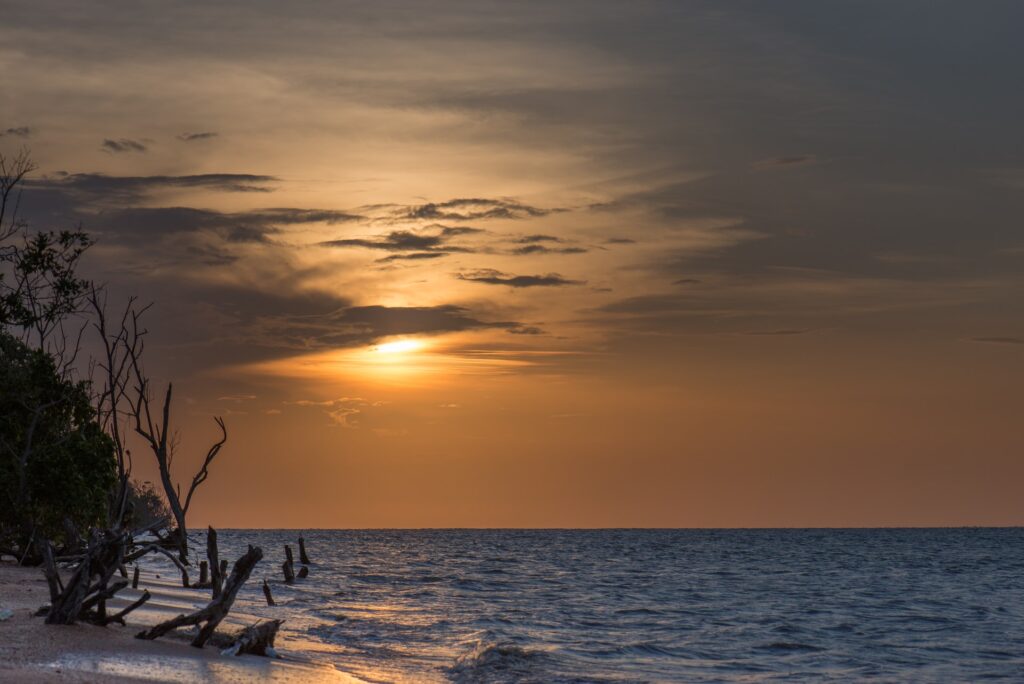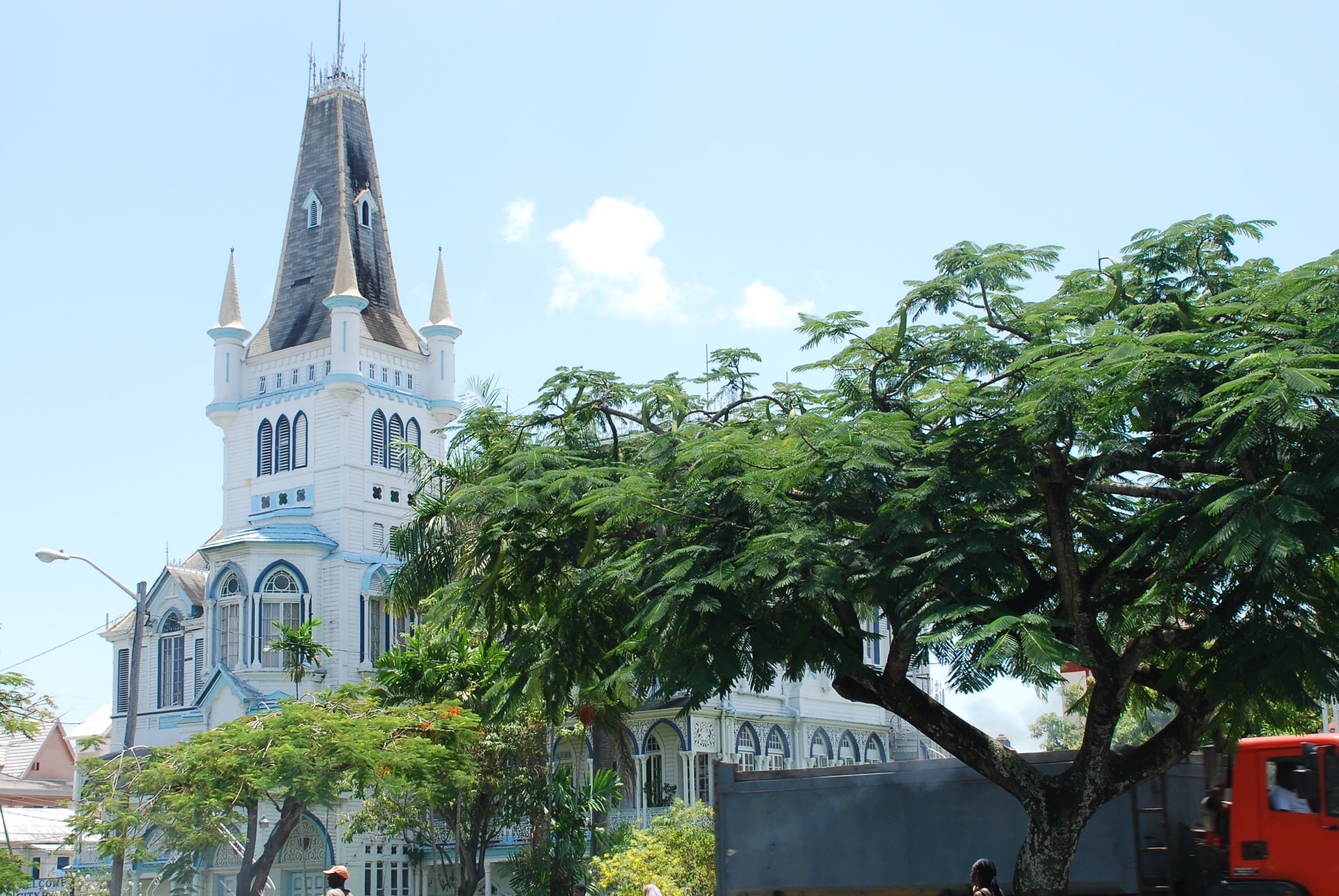The northernmost region of South America, with a coastline along the Caribbean Sea, is known as Guiana – an old indigenous word meaning ‘land of many waters’. For centuries it was home to the Arawok and Carib peoples, who were very similar, despite their rivalry. Whilst the region was first spotted by Christopher Columbus in 1498, and occasionally visited by the Spanish colonists operating in that part of the world, it wasn’t until 1594 that foreign interest in the region really peaked, when English statesman Sir Walter Raleigh, led a journey into the virgin forests, in an attempt to find a lost city of gold, which was rumoured to exist somewhere near the Orinoco basin. The mythical location has come to be known as El dorado.
Raleigh’s fleet landed at what is present day Guyana, and went in search of the golden city, which was allegedly located somewhere along the shores of Lake Parima. He didn’t find the city or the lake, and his account of the expedition – which was published after he returned to England – really stretched the limits of credulity. Raleigh led a second expedition to find El dorado in 1616, and was again, unsuccessful. When his party ransacked a Spanish outpost – in violation of a previous treaty between England and Spain – he was ordered home and executed.
THE RACE FOR THE GOLD
By now the region was famous, and so the Dutch, French, English, Spanish, Portuguese and briefly, the Italians, all began vigorously exploring the area in search of treasure. Chaos reigned supreme in Guiana over the next few centuries. Conflicts between different settlers over territory, in addition to conflicts between the natives and the settlers over the plundering of natural resources, made life in the region quite hazardous.
In the early 19th century there was some semblance of order, and the region was carved into 3 new colonies; British Guiana, Dutch Guiana and French Guiana. The parts of western Guiana under Spanish control were assimilated into their existing colony of Venezuela, just as Portuguese Guiana in the east, became part of Brazil. The physical characteristics of all these territories are practically the same. Each has a fertile alluvial foreshore, with upward-sloping savannahs and forests to the unexplored highlands, dense with primeval jungle.
BRITISH GUIANA
British Guiana resulted from the rapid increase in land acquisition and the establishment of plantations, which were populated by slaves from Africa. The conditions were harsh and there were several slave uprisings which were put down by European troops. The British government later encouraged its own citizens to migrate to the colony, which many did, and it remained a part of the commonwealth until becoming an independent Republic in 1966, upon which it was renamed Guyana. The official language is still English, which means that Guyana, despite being in South America, is not considered part of Latin America.
Culturally, Guyana has more in common with the Caribbean than with Latin America. The Caribbean creole variation on the English language is popular, and they are 1 of 15 countries that make up the hugely successful West Indies Cricket Team. Some of the cricketing legends that Guyana has produced over the years include Lance Gibbs, Colin Croft, Clive Lloyd, Alvin Kallicharran, Rohan Kanhai, Shivnarine Chanderpaul, Carl Hooper and many others.
On the downside, Guyana was the location of the infamous Jonestown tragedy which occurred in November 1978. Jonestown was an isolated agricultural settlement in the north of the country established by American cult leader, Jim Jones, the head of the “Peoples Temple” Church in San Francisco. After concerned relatives of cult members lobbied the US Government, California congressman Leo Ryan lead a delegation to the commune to investigate the rumours of human rights abuse. On the orders of Jim Jones, the entire cult membership was poisoned and Congressman Ryan and his team were gunned down. Jones and the other leaders committed suicide – 918 people died in total.
DUTCH GUIANA
The Dutch colony in Guiana followed a similar economic model to their British neighbours, and also imported slave labour from Africa to work in the ever expanding sugar plantations. With the help of the Indigenous Tribes, many slaves escaped the plantations and formed a new community deep in the jungles of the Amazon – this group came to be known as the ‘Maroons’, and to this day, is considered a distinct ethnicity.
Following the abolition of slavery, Dutch Guiana would later hire indentured labour from Japan, China, India and the Middle East. In 1975, the colony achieved its independence and became known as the Republic of Suriname. With Dutch as the official language, and with more folks migrating from Hispaniola and Cuba, the modern nation of Suriname is one of the most ethnically diverse nations on earth.
As a result if this diversity, Suriname celebrates many different ethnic and religious festivals, and has around 20 National holidays every year. Culturally, it is firmly a part of the Caribbean. Economically, it is still a work in progress. However, its lush natural beauty and biodiversity has made it a magnet for Tourists, and the Scientific community. A staggering 95% of Suriname’s landmass is covered in forest – the most of any country.
FRENCH GUIANA
French Guiana is still not an independent country, it is an overseas territory belonging to France. This means that it is officially part of France – and by extension – part of the European Union, despite being very firmly on the continent of South America. The first Europeans to land at this site were the Italians, but they soon abandoned the expedition.
After a horrible start, which involved famine and the loss of soldiers due to tropical diseases, the French would eventually get a foot hold in this part of the Guiana’s. Like the other European powers, they established plantations and brought in slave labour, but they also used the territory as a penal colony. Not many of the prisoners would survive their incarceration.
Unlike its neighbours, French Guiana has a fairly solid economy, thanks to the large subsidies it receives from France, in addition to being the location of a major spaceport. The Guiana Space Centre is located in the district of Kourou, and is regularly used for rocket launches by the European Space Agency, the French Space Agency (CNES) as well as private companies like Arianespace and Azercosmos. The location is ideal given that it’s close to the equator (less energy required for the launch) and is adjacent to the ocean, in case of any falling debris or a crash landing.
THE FUTURE?
Five different Guiana’s became three, and now only two bear the regions original name, albeit spelled differently. There are various mutterings about French Guiana one day gaining independence, but there’s nothing concrete which suggests it’s going to happen any time soon. If it does happen, let’s just hope that they follow their neighbours in Suriname, and come up with an original name. This magnificent part of the world deserves to be way more famous than it currently is.


